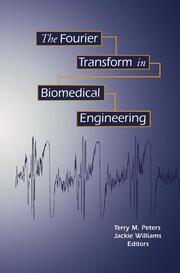-
Zusatztext
-
In 1994, in my role as Technical Program Chair for the 17th Annual International Conference of the IEEE Engineering in Medicine and Biology Society, I solicited proposals for mini-symposia to provide delegates with accessible summaries of important issues in research areas outside their particular specializations. Terry Peters and his colleagues submitted a proposal for a symposium on Fourier Trans forms and Biomedical Engineering whose goal was "to demystify the Fourier transform and describe its practical application in biomedi cal situations". This was to be achieved by presenting the concepts in straightforward, physical terms with examples drawn for the parti cipants work in physiological signal analysis and medical imaging. The mini-symposia proved to be a great success and drew a large and appreciative audience. The only complaint being that the time allocated, 90 minutes, was not adequate to allow the participants to elaborate their ideas adequately. I understand that this feedback helped the authors to develop this book.
-
-
Autorenportrait
- Inhaltsangabe1 Introduction to the Fourier Transform.- 1.1 Introduction.- 1.2 Basic Functions.- 1.3 Sines, Cosines and Composite waves.- 1.4 Orthogonality.- 1.5 Waves in time and space.- 1.6 Complex numbers. A Mathematical Tool.- 1.7 The Fourier transform.- 1.8 Fourier transforms in the physical world: The Lens as an FT computer.- 1.9 Blurring and convolution.- 1.9.1 Blurring.- 1.9.2 Convolution.- 1.10 The "Point" or "Impulse" response function.- 1.11 Band-limited functions.- 1.12 Summary.- 1.13 Bibliography.- 2 The 1-D Fourier Transform.- 2.1 Introduction.- 2.2 Re-visiting the Fourier transform.- 2.3 The Sampling Theorem.- 2.4 Aliasing.- 2.5 Convolution.- 2.6 Digital Filtering.- 2.7 The Power Spectrum.- 2.8 Deconvolution.- 2.9 System Identification.- 2.10 Summary.- 2.11 Bibliography.- 3 The 2-D Fourier Transform.- 3.1 Introduction.- 3.2 Linear space-invariant systems in two dimensions.- 3.3 Ideal systems.- 3.4 A simple X-ray imaging system.- 3.5 Modulation Transfer Function (MTF).- 3.6 Image processing.- 3.7 Tomography.- 3.8 Computed Tomography.- 3.9 Summary.- 3.10 Bibliography.- 4 The Fourier Transform in Magnetic Resonance Imaging.- 4.1 Introduction.- 4.2 The 2-D Fourier transform.- 4.3 Magnetic Resonance Imaging.- 4.3.1 Nuclear Magnetic Resonance.- 4.3.2 Excitation, Evolution, and Detection.- 4.3.3 The Received Signal: FIDs and Echos.- 4.4 MRI.- 4.4.1 Localization: Magnetic Field Gradients.- 4.4.2 The MRI Signal Equation.- 4.4.3 2-D Spin-Warp Imaging.- 4.4.4 Fourier Sampling: Resolution, Field-of-View, and Aliasing.- 4.4.5 2-D Multi-slice and 3-D Spin Warp Imaging.- 4.4.6 Alternate k -space Sampling Strategies.- 4.5 Magnetic Resonance Spectroscopic Imaging.- 4.5.1 Nuclear Magnetic Resonance Spectroscopy: 1-D.- 4.5.2 Magnetic Resonance Spectroscopic Imaging: 2-D, 3-D, and 4-D.- 4.6 Motion in MRI.- 4.6.1 Phase Contrast Velocity Imaging.- 4.6.2 Phase Contrast Angiography.- 4.7 Conclusion.- 4.8 Bibliography.- 5 The Wavelet Transform.- 5.1 Introduction.- 5.1.1 Frequency analysis: Fourier transform.- 5.2 Time-Frequency analysis.- 5.2.1 Generalities.- 5.2.2. How does time-frequency analysis work?.- 5.2.3 Windowed Fourier transform.- 5.2.4 Wavelet transform.- 5.3 Multiresolution Analysis.- 5.3.1 Scaling Functions.- 5.3.2 Definition.- 5.3.3 Scaling Relation.- 5.3.4 Relationship of multiresolution analysis to wavelets.- 5.3.5 Multiresolution signal decomposition.- 5.3.6 Digital filter interpretation.- 5.3.7 Fast Wavelet Transform Algorithm.- 5.3.8 Multidimensional Wavelet Transforms.- 5.3.9 Fourier vs. Wavelet Digital Signal Processing.- 5.4 Applications.- 5.4.1 Image Compression.- 5.4.2 Irregular heart beat detection from EKG signals.- 5.5 Summary.- 5.6 Bibliography.- 6 The Discrete Fourier Transform and Fast Fourier Transform.- 6.1 Introduction.- 6.2 From Continuous to Discrete.- 6.2.1 The comb function.- 6.2.2 Sampling.- 6.2.3 Interpreting DFT data in a cyclic buffer.- 6.3 The Discrete Fourier Transform.- 6.4 The Fast Fourier Transform.- 6.4.1 The DFT as a matrix equation.- 6.4.2 Simplifying the transition matrix.- 6.4.3 Signal-flow-graph notation.- 6.4.4 The DFT expressed as a signal flow graph.- 6.4.5 Speed advantages of the FFT.- 6.5 Caveats to using the DFT/FFT.- 6.6 Conclusion.- 6.7 Bibliography.
Detailansicht
The Fourier Transform in Biomedical Engineering
Applied and Numerical Harmonic Analysis
ISBN/EAN: 9781461268499
Umbreit-Nr.: 4535602
Sprache:
Englisch
Umfang: xix, 199 S., 45 s/w Illustr.
Format in cm:
Einband:
kartoniertes Buch
Erschienen am 12.10.2012
Auflage: 1/1998


